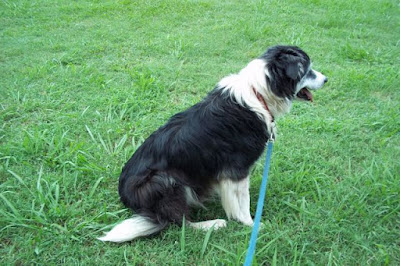"Me and My Mommy View the Eclipse"
by Maggie, a geriatric border collie
Some of you who've read this blog for a long time will remember I used to post when I was younger. If so, you remember that I decided to be a kennel dog when I was about a year old even though my mommy had bought me to be a house dog. A couple of months ago, after a decade of being a kennel dog, I made a career change and became a house dog again. A few months ago, I had to have surgery on my ear, so I got used to being in the house while I recuperated.
I don't stay in the house all the time. I make Mommy take me outside. She has to use a golf-cart because she can't walk good so I walk beside it. She keeps me on a leash because she knows I might slip away if she wasn't watching. Anyhow, Mommy said were going to see an eclipse. I wasn't sure what one was, but it involved going outside. Once we were out, Mommy looked at the sky but she said there were too many clouds.
She said the eclipse might be behind these clouds.
I looked around but I didn't see anything.
I did see some blue sky toward Smith Mountain, but she said that the sun wasn't over that way.
She said the eclipse was taking place behind these clouds, so we were missing it. I still couldn't figure out what it was.
Before long, Chloe saw us looking at the sky and decided to join us.
I like Chloe better than the house cats because she doesn't mess with me the way certain house cats do. She doesn't try to take my toys like Alfreda does or smack me like Arlo does or—Oh, I guess I'm getting off-track. Anyhow, Chloe and I sat down to wait for whatever Mommy was waiting for.
Waiting for the eclipse was boring, so we took a little nap.
After we'd napped for a while, I asked Chloe what an eclipse was supposed to be, and she said it was when the moon blocked out the sun, but the sun still shone around the edges. "It looks like the end of my tail," Chloe said, and held up her tail to show me.
I thanked Chloe for her explanation. "You're welcome," she said. "Always glad to help out a good dog."
Back up in the sky, not much was happening. Mommy said she could see a little sliver of sun every once in a while, but I didn't see anything.
Chloe had some cat-work to do so she left, but I had to stay with Mommy. Finally Mommy got tired of waiting too.
I don't see why she couldn't have just looked at Chloe's tail. It would have saved a lot of time.
~
Labels: border collie, cat, clouds, weather

































